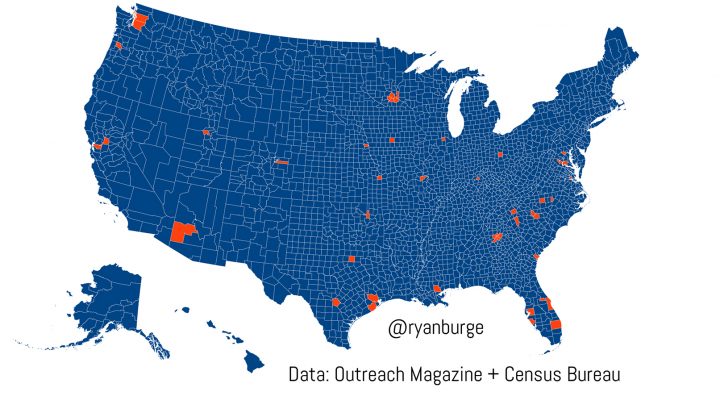If you want to have a fast-growing church, there are 47 counties in America that fit the ideal criteria for success, according to an empirical analysis by Ryan Burge.
Successful church plants today most often meet these four criteria, Burge reports:
- Population growth: “Look for a county with at least 10% population growth between 2010 and 2020.”
- Mobility: “Aim for a place where 2.5% to 5% of the population has moved within the last 12 months.”
- Education: “This is crucial. Target a county where at least 30% of adults have a college degree.”
- Population density: “Ideally, seek areas with at least 500 people per square mile.”
The social scientist identified these criteria by analyzing Outreach magazine’s list of the fastest-growing churches in the nation from 2015 through 2022. That produced a pool of 155 churches.
From that set, he compared the church locations to available demographic data on a county level. He found almost all those churches are located in counties that are growing; only 7% were located in counties with declining populations.

Ryan Burge
“This reinforces a common observation,” he said. “Churches experiencing rapid growth are often located in counties undergoing significant population increases. While three-quarters of all counties grew by less than 5% in the previous decade, this only applied to 21% of the churches on the Outreach list.”
Further, 62% of the fast-growing churches are located in counties that experienced double-digit population growth. That kind of growth was found in only 13% of U.S. counties.
Mobility, though, is a trickier metric. What Burge found is that fast-growing churches tend to be in counties with at least 5% newcomers annually but not extreme mobility. A baseline of mobility is needed to draw in newcomers, but too much mobility indicates instability in a community.
Education is another important factor, he found. “Fast-growing churches are predominantly found in highly educated counties. Nearly three-quarters of the churches on the Outreach list are located in counties where at least 30% of the population holds a college degree. For comparison, only 20% of all counties across the country meet this same educational threshold. This unequivocally demonstrates that churches in communities with higher levels of education have a much easier path to growth than those in less educated areas.”
Churches also are more likely to grow if they are located in high-density areas, he said. “The majority of Outreach-listed churches are located in areas with a population density of between 100 and 500 people per square mile. While just 12% of all U.S. counties fall into this category, they account for over half of the fastest-growing churches.”
In his Substack post, Burge includes interactive maps and links to data.


